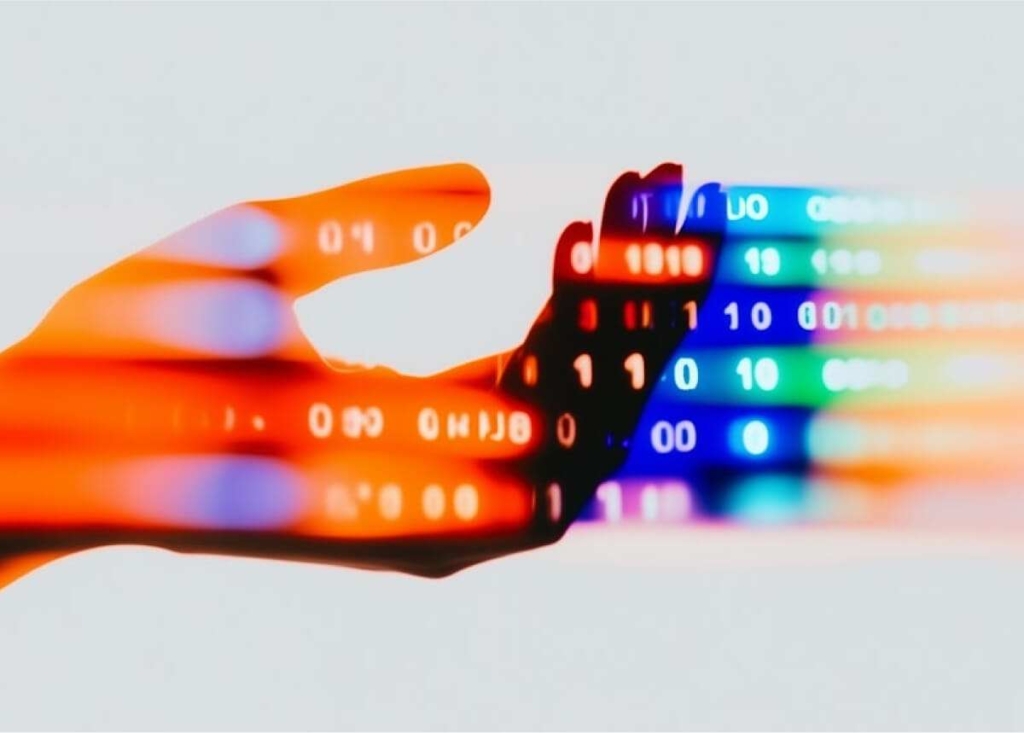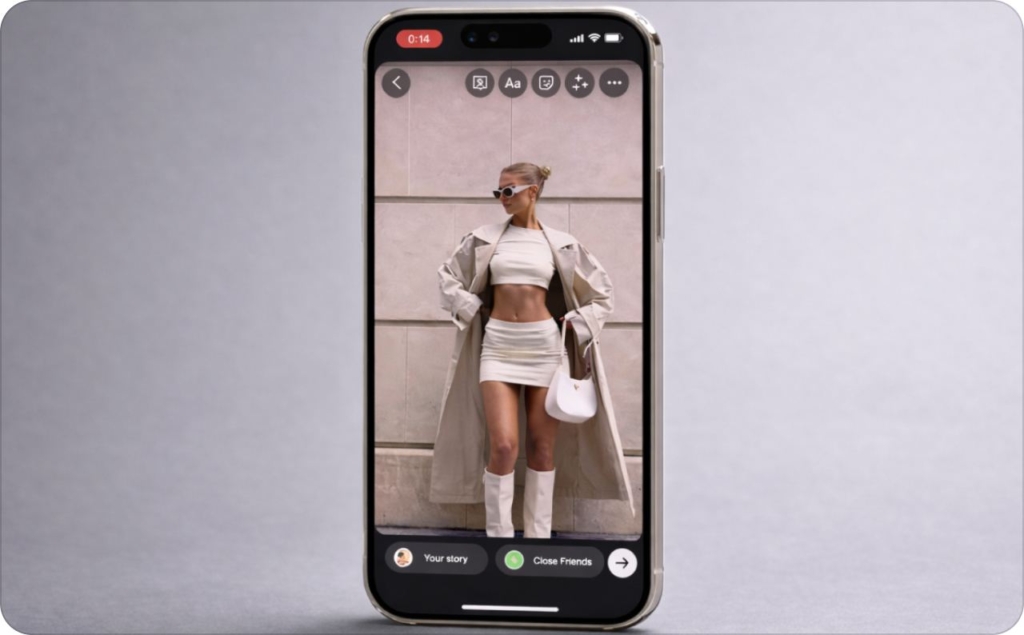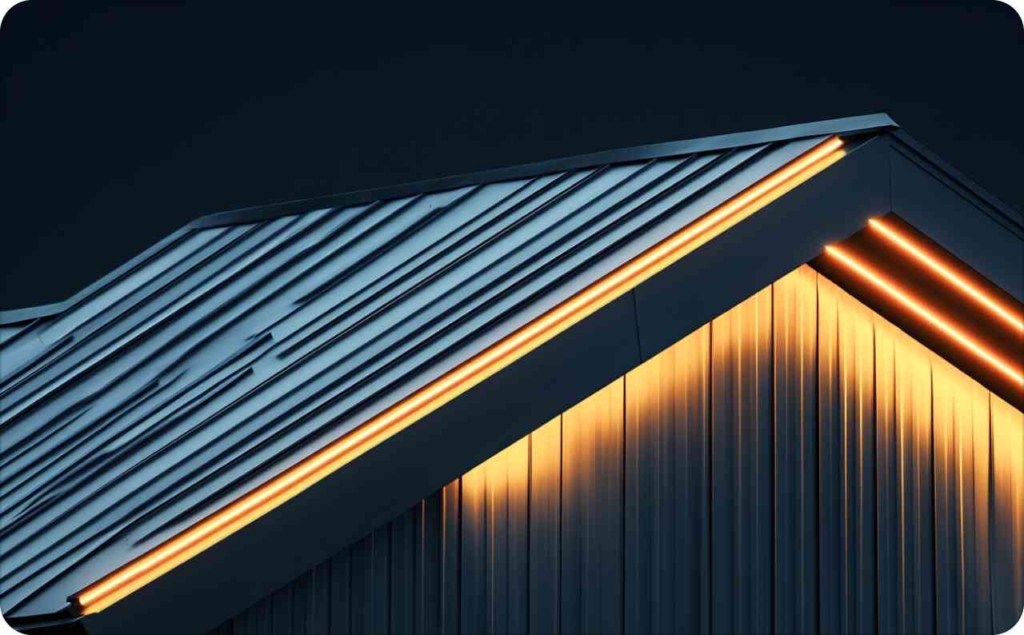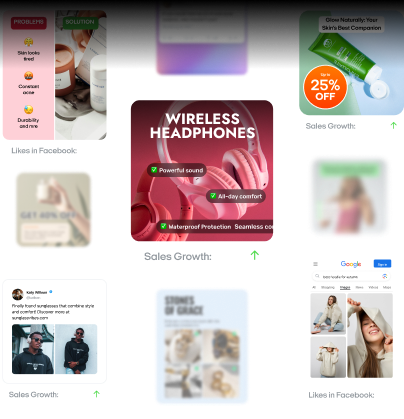Brand-created ads vs AI UGC ads: Which one is the best for your marketing strategy?
Should you stick with traditional brand ads or go AI-powered? Zeely AI compares both approaches to reveal which delivers better engagement, efficiency, and creative performance.
Marketers have traditionally relied on brand-created ads — professionally produced content crafted by creative directors, production crews, and post-editing teams. These ads offer control, polish, and precision. You get what you plan for: scripted storytelling, high-caliber visuals, and seamless delivery across channels. But this consistency comes at a price — high costs, long lead times, and a lack of agility that often lags behind consumer demand.
On the other side of the spectrum, a new format has entered the scene: AI UGC video ads creator. These ads use platforms like Zeely AI, Synthesia, DeepBrain, and InVideo to generate content that feels real, personal, and native to social platforms. With the push of a button, you can generate dozens of customized video testimonials, product showcases, or influencer-style content, without hiring actors or booking studio time.

What are brand-created ads and how are they made?
It’s a professionally produced video or multimedia ad built by a creative production team, usually involving a copywriter, creative director, producer, videographer, editor, and often a project manager. These ads are carefully scripted, shot on-location or in-studio, and refined through multiple rounds of editing to ensure every detail aligns with your brand identity.
It begins with strategy. Your team defines the core message, campaign goal, and audience segment. A scriptwriter develops a storyboard with a clear narrative arc, while a producer hires professional actors, scouts locations, and arranges wardrobe, props, and crew. The shoot itself is tightly controlled — each shot planned, each take evaluated by the director and client team in real time.
Post-production is where the visual refinement happens. Editors color-grade the footage, sync sound, add motion graphics, and apply finishing touches to deliver a high-caliber result. Legal, brand, and stakeholder approvals follow, often requiring multiple revisions before the final export is cleared for launch.
Production cycles often span 3–8 weeks. Budgets can run into six figures. And because of the time and cost involved, you usually end up with only a few ad variations, limiting opportunities for rapid testing or adaptation. When creative control, scripted storytelling, and high-production quality are your top priorities, traditional brand-created ads still deliver.
Pros and cons of brand-created ads
When brand control matters most, few formats can compete. Let’s break down the benefits and challenges of brand-created ads, so you can decide when they’re worth the investment.
| Aspect | Pros of brand-created ads | Cons of brand-created ads |
| Creative control | Total message control, scripted narratives, and precise visual direction. | Limited flexibility, every change requires multiple approval layers. |
| Production quality | High-end visuals and audio, perfect for premium ad campaigns and TV spots. | Can appear overly polished or “corporate,” which may reduce relatability, especially among younger audiences. |
| Brand consistency | Strong alignment with brand image, tone, and guidelines. | Difficult to quickly adapt to evolving trends or audience feedback. |
| Compliance & legal | Ideal for regulated industries, where messaging must pass legal and internal review. | Compliance processes often add weeks to turnaround timelines. |
| Cost | Establishes value perception, especially for enterprise-level launches. | Expensive: $25K–$100K per 30-second spot due to crews, equipment, actors, and post-production. Limits multivariate testing. |
| Speed to launch | Great for long-term campaigns with months of lead time. | Slow turnaround, can take weeks or months from brief to final cut. |
| A/B testing agility | Allows for deep storytelling in hero campaigns. | Not suited for rapid iteration or testing multiple creative angles due to high cost and long production cycles. |
| Audience perception | Builds trust through quality, especially for premium brands or high-stakes offerings. | May fall short in authenticity, especially when audiences expect real, unscripted voices or behind-the-scenes-style storytelling. |
When to use brand-created ads
Choose this format when message precision, brand polish, and compliance are non-negotiable. These ads shine in product launches, brand positioning, and corporate storytelling, not when you need speed, flexibility, or real-time optimization.
What are AI UGC ads?
They’re ads generated by artificial intelligence that simulate the tone, delivery, and structure of authentic user testimonials. Instead of filming real customers or hiring creators, brands use AI tools, like Zeely AI or Synthesia, to produce video, image, and text-based content that looks like it came from a real person.
The technology behind it relies on advanced AI algorithms trained to mimic human speech, expressions, and behavior. You feed in a script and select your avatar, voice, or image style, and the platform delivers machine-crafted content, instantly optimized for your chosen channel. This is automated creativity at work, built to solve the time, scale, and budget limitations of traditional or organic UGC.
The difference between UGC video and AI UGC is significant. Unlike influencer-generated content, AI UGC gives you full control over tone, compliance, and message. And unlike studio video, there’s no need for cameras, crews, or casting.
That said, authenticity is still a key concern. If delivery feels robotic or visuals dip into the uncanny valley, performance may drop. And as digital transparency laws expand, AI-generated content must be clearly labeled to remain compliant.
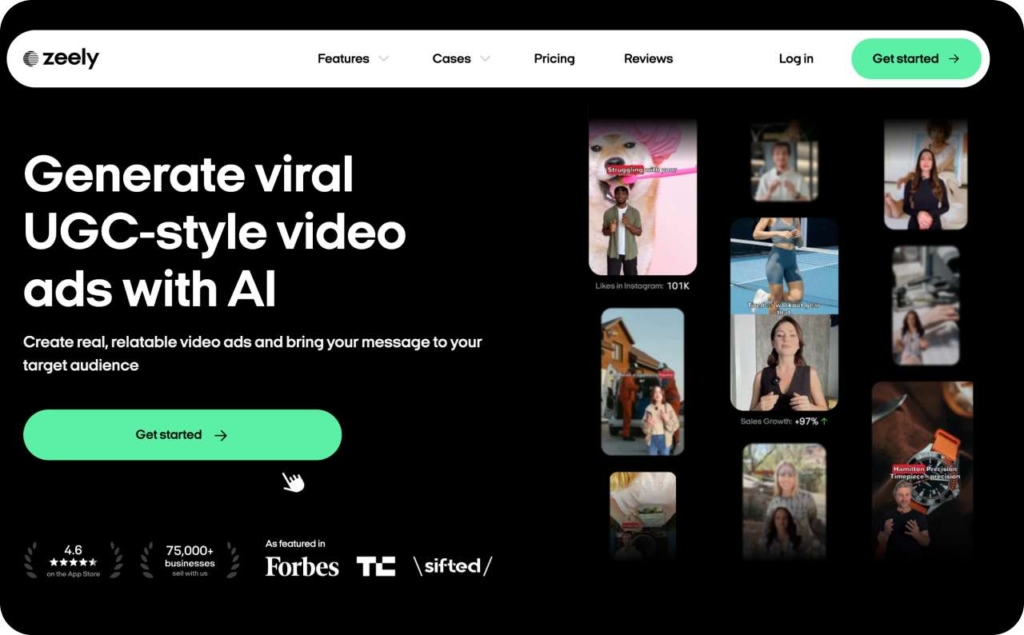
Types of AI UGC ads: Text, image, video, and reviews
Today’s creative stacks let you spin out text, image, video, and review‑style assets in minutes, each matched to a funnel stage or channel. Understanding these types of AI UGC ads helps you map the right format to the right goal, avoiding wasted budget and boosting relevance from first scroll to final click.
Video testimonials: Trust at scale
You want ads that look human and you need them yesterday. AI video ads vs text ads deliver exactly that. Platforms like Zeely AI let you drop a script and spin out avatar‑led video reviews in multiple languages within hours. One skincare brand generated 15 bilingual testimonials for TikTok and Reels, cutting production time from two weeks to 36 hours and lowering cost‑per‑result by 28%. Because each clip follows your brand script and visual rules, you preserve consistency while speaking to local markets with native‑sounding voiceovers and synced facial expressions.
Text‑based UGC: Copy that converts
Product pages die without fresh social proof. Text‑based ads — automated reviews, feature blurbs, chat‑style captions, let you update copy on demand. A home‑fitness retailer used AI to create 30 micro‑reviews, each highlighting a different benefit. A/B testing these snippets boosted add‑to‑cart rate by 17% in one week. Because the language engine pulls directly from your approved messaging, every line stays on‑brand while giving you the variety needed for true A/B testing at scale.
AI imagery: Photoshoot‑free visuals
Need lifestyle shots but can’t book talent? AI image testimonials produce synthetic models interacting with your product under perfect lighting. A smartwatch brand swapped a costly studio session for AI imagery, generating five seasonal hero banners in 48 hours and slicing creative spend by 65%. Facial expressions, backgrounds, and product angles are all adjustable, so you can localize ads for beach, urban, or winter settings without a single reshoot — ideal for rapid‑fire social media content refreshes.
Review overlays: Credibility in one glance
Shoppers trust stars more than slogans. AI can auto‑generate branded quote cards, star‑rating blocks, and side‑by‑side comparisons that drop into landing pages or carousel ads. An online mattress company layered AI review overlays onto remarketing ads and saw a 22% uplift in click‑through rate. Each overlay matches brand colors, uses verified quotes, and remains compliant with disclosure rules, solving the authenticity puzzle without manual design cycles.
Cross‑channel customization: Modularity wins
The true power of types of AI UGC ads lies in modular delivery. Swap tone, length, or layout for TikTok, LinkedIn, Instagram, or YouTube without re‑filming or re‑designing. A SaaS startup repurposed one avatar testimonial into five platform‑specific cuts — vertical for Shorts, square for Feed, landscape for Pre‑Roll, doubling impressions while maintaining a single source file.
Pros and cons of AI UGC ads
If you’re scaling content fast and testing daily, AI UGC can feel like a creative cheat code. But speed without strategy leads to friction. Let’s break down the benefits and drawbacks, so you know exactly when to deploy this format for maximum ROI.
| Aspect | Pros of AI UGC ads | Cons of AI UGC ads |
| Cost efficiency | Delivers up to 28% lower CPR and 31% lower CPA in performance-driven funnels thanks to faster production and broader creative testing. | None in this area — cost savings are a core strength, but efficiency may drop if execution quality is poor. |
| Production speed | Enables rapid content creation, ideal for high-volume testing and short campaign cycles. | Quality may vary depending on AI model sophistication and oversight. |
| Personalization | Easily localize or segment content by language, tone, or visuals without extra production overhead. Great for multilingual or cross-market campaigns. | May lack the emotional depth of fully custom, human-driven storytelling. |
| Brand consistency | AI-generated scripts stick to brand-approved language and visuals, unlike traditional UGC. | Over-optimization can result in content that feels robotic or templated. |
| Authenticity | Structured outputs reduce risk of off-brand messaging often found in unvetted UGC. | May appear unnatural or synthetic, especially if facial animations or voiceovers are poorly aligned. |
| Compliance | Can be pre-programmed for regulatory safety with script control and disclaimers. | New laws like the Digital Transparency Act require AI ads to be labeled, noncompliance risks legal and brand trust issues. |
| Creative flexibility | Great for modular content, A/B testing, and quick iterations across ad sets. | Limited in humor, emotion, and nuance. AI still lags in storytelling and improvisation, especially for emotionally-driven campaigns. |
When to use AI UGC ads
Choose AI UGC ads when you need high-volume, personalized, and conversion-focused creative at scale, especially for paid social, e-commerce, or global campaigns. Just remember: performance grows when AI is paired with human oversight, testing frameworks, and an eye for authenticity.
Side-by-side comparison: Brand-created ads vs. AI UGC ads
Brand-created ads are polished and perfectly on-brand, but that very polish can sometimes create distance. On platforms like TikTok and Instagram, where authenticity rules, traditional creative often feels too scripted or overly produced to resonate. The result? Content that looks expensive, but scrolls right past engagement.
AI UGC ads offer a compelling alternative. These formats simulate genuine user reviews and peer-to-peer storytelling that feels natural and native to the feed. Tools like Zeely AI and Synthesia let you generate on-demand video or text testimonials that mimic real customer voices, even if they’re AI-scripted.
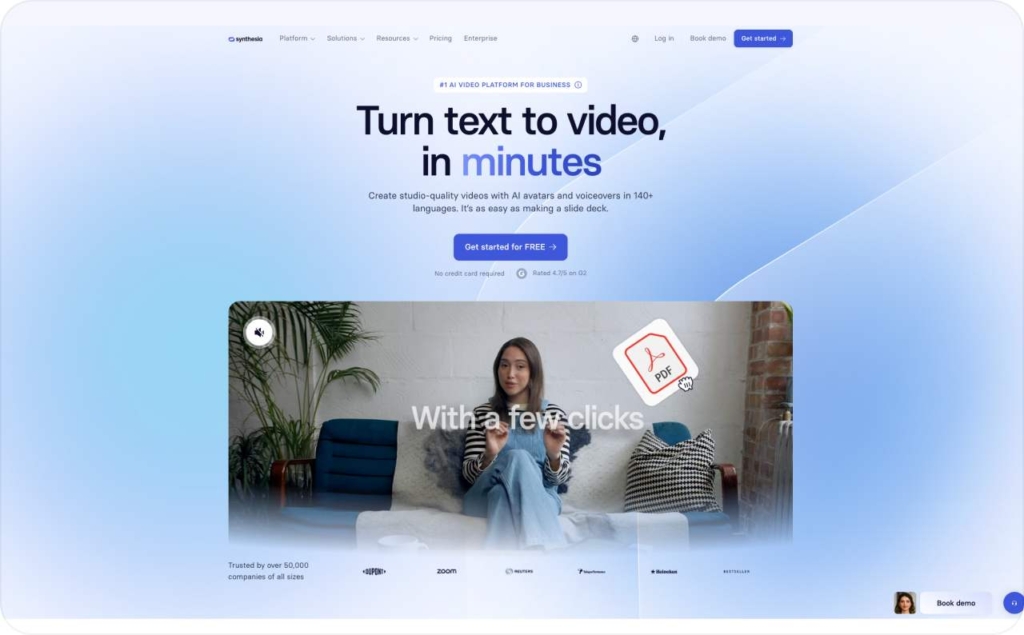
Photo source: Synthesia
And this relatability matters. According to Entrepreneur, more than one in three U.S. adults always read customer reviews before buying from local businesses. That trust in peer-driven content makes AI-powered UGC a powerful lever for building credibility and conversion, especially when you can scale messaging instantly without sacrificing consistency.
Cost, speed & agility
Brand-created content typically costs $25K–$100K+ per video, not including creative agency fees or reshoots. The full cycle can stretch over 6–8 weeks.
AI UGC ads flip that model. With automated scripting and avatar rendering, production costs drop to $2K–$5K per campaign set, and turnaround time shortens to 48–72 hours. More importantly, you gain testing agility: imagine launching 15 variants in a week, without needing another shoot.
In Q2 2024, a direct-to-consumer skincare brand replaced 60% of its manually produced creatives with AI UGC variants. The result? 29% increase in ROAS and a 38% reduction in creative production cycle time.
Performance & ROI
Here’s what performance data reveals:
- AI UGC campaigns deliver up to 28% lower cost-per-result
- They also show 31% lower cost-per-acquisition on average across paid social
- Brand-created ads lead in top-of-funnel awareness, with higher brand lift and perceived credibility in premium verticals like finance or luxury
Put simply, AI UGC ads dominate in bottom-of-funnel conversion, while brand-produced assets maintain strength in storytelling and prestige-based positioning.
Quick performance snapshot
Here’s a digital ad engagement metrics table comparing both formats:
| Category | Brand-created ads | AI UGC ads |
| Trust & authenticity | High in corporate or luxury spaces | Higher in mobile-first social contexts |
| Visual appeal | Studio-grade, cinematic | Platform-native, casual |
| Production cost | $25K–$100K+ per asset | ~$2K–$5K per multivariate set |
| Time to launch | 4–8 weeks | 2–3 days |
| Testing agility | Low — linear, manual | High — parallel, automated |
| Scalability | Resource-constrained | Automated, multiformat ready |
| Best use case | Product launches, investor ads | Retargeting, performance creatives |
This cost-benefit analysis clearly shows the trade-off: creative control vs rapid scale.
When to use which type of ad
Use brand-created ads when control, quality, and brand messaging are non-negotiable. These ads are ideal for high-stakes campaigns, think flagship product launches, brand repositioning, or investor-backed marketing pushes, where every detail must reflect your identity and standards.
Let’s say you’re introducing a luxury skincare line. You can’t risk a poorly lit testimonial or off-brand tone. You need precision: a team of creatives, directors, and editors crafting a narrative that feels cinematic and completely on-brand. In these moments, polished production isn’t a bonus, it’s a requirement.
Brand-created ads often involve scripted storytelling, studio-grade visuals, and professional actors. While they typically cost 3–5x more than AI-generated ads, the ROI lies in long-term brand equity. According to Nielsen, professionally produced campaigns have a 20–40% higher brand recall rate and perform 30% better in upper-funnel brand lift metrics. That kind of consistency is crucial when you’re building or defending a premium market position.
These ads also make sense when internal stakeholders demand tight creative control or when marketing compliance is a concern. You’re not just telling a story, you’re safeguarding a reputation.
Use brand-created ads when your message must be tailored, flawless, and campaign-specific. They’re your go-to for moments that define how your brand will be remembered.
Scenarios ideal for AI UGC ads
AI UGC ads are your best tool when speed, scale, and personalization outweigh the need for polish. They thrive in fast-paced campaigns — flash sales, influencer-style content pushes, or always-on paid social where volume matters more than cinematic perfection.
Let’s say you run a DTC apparel brand about to drop a new seasonal line. You don’t need six weeks and a studio shoot. You need 10 variations of relatable, testimonial-style video ads that can be launched by tomorrow and tested against real-time performance data. That’s where tools like Zeely AI or Synthesia come in, generating algorithm-driven video and text ads at scale.
What makes AI UGC stand out is its agility. You can create content on-demand, personalize it by audience segment, and rotate creatives daily based on clickthrough performance. In fact, brands using AI-powered ad creative report up to 28% lower cost per result and 31% lower CPA, according to Meta’s internal benchmarks.
This format also excels in lower-budget campaigns or emerging markets where maximizing reach and relatability is more important than producing a perfectly scripted narrative. When speed-to-market and creative iteration are your top priorities, AI UGC removes traditional barriers, without sacrificing resonance.
Use AI UGC ads when you need agile delivery, dynamic content, and automated creativity that speaks directly to your audience. They’re built for campaigns that move fast and adapt even faster.
Hybrid approaches & future trends
Still treating brand-created ads and AI UGC campaigns as separate strategies? You might be leaving serious performance gains on the table. Today’s most agile marketers aren’t choosing between polish and scale, they’re combining them.
Hybrid ad campaigns merge the storytelling control of brand-created ads with the speed, personalization, and affordability of AI UGC content. This synergy lets you hit high-impact awareness goals while also maintaining cost-efficient performance across platforms.
Think of it as campaign orchestration: your brand video becomes the hero piece for YouTube and CTV, while AI-generated testimonials tailored by Zeely AI roll out simultaneously across Meta, TikTok, and email retargeting.
Here’s how a hybrid strategy plays out:
- Start with the brand anchor. Use a professionally shot video to establish your campaign’s message, tone, and visual identity
- Scale through AI UGC variants. Deploy AI-powered reviews, reactions, or regionalized versions that echo your core message but feel native to the platform
- Map messaging by funnel stage. Keep top-of-funnel touchpoints polished and controlled, while allowing AI to drive mid-funnel experimentation and bottom-funnel performance testing
- Measure, iterate, optimize. Monitor key hybrid KPIs, like view-through rate for hero content and CPA for AI UGC variants. Blend insights to optimize the full journey
For example, one lifestyle brand saw a 37% drop in CPA and 2.4x increase in ROAS after pairing their flagship brand film with Zeely-powered UGC variants tailored for influencers and micro-niche audiences. The blend allowed the brand to maintain control over tone while activating community-scale relevance at speed.
So, if you’re aiming for scale without sacrificing quality, a hybrid advertising strategy isn’t just an alternative, it’s your next growth lever. Now let’s look ahead: the way we produce and regulate digital ads is evolving even faster than the platforms themselves.
Trends & predictions in digital ad production
AI isn’t just changing how we create ads, it’s redefining the rules of marketing itself. As personalization gets smarter and compliance gets stricter, you’ll need to stay ahead of more than just creative trends.
Looking forward, real-time content generation is becoming the norm. Tools like Zeely AI are already optimizing performance through algorithm-driven customization, adjusting voice, visuals, and call-to-actions on the fly.
Regulatory shifts like the EU AI Act or FTC guidance around AI-generated content will demand transparency, audit trails, and explicit labeling of synthetic ads. That means your future creative workflows must bake in compliance by design — from prompt to publishing.
Meanwhile, collaboration between human creatives and machine learning models will become the new norm. Imagine creative teams acting as “ad conductors,” shaping high-level narratives while AI fills in multivariate permutations across markets, audiences, and goals. The result? Increased velocity without sacrificing cohesion.
One global retailer piloted predictive creative A/B testing, where generative models produced 30 variants of their core ad concept. The result? A 19% lift in engagement and a 22% faster creative-to-launch cycle.
If you want to future-proof your ad strategy, think beyond format. Plan for innovation, forecast compliance, and embrace predictive creativity, because the future of advertising won’t be about replacing humans with AI, but partnering with it to outperform the market.
Introducing Zeely AI as the game changer
Most marketers struggle to scale creative content without sacrificing consistency or authenticity. That’s where Zeely AI steps in, not as another AI gimmick, but as a powerful production engine designed for performance and brand precision.
Automate quality without compromising brand voice
Zeely AI transforms how you create AI UGC ads by merging automated video production with tight brand control. Platform auto-generates video ad scripts that match your tone, selects AI avatars or testimonial styles, and assembles finished ads — all in a matter of minutes. Think of it as your on-demand creative team, minus the overhead.
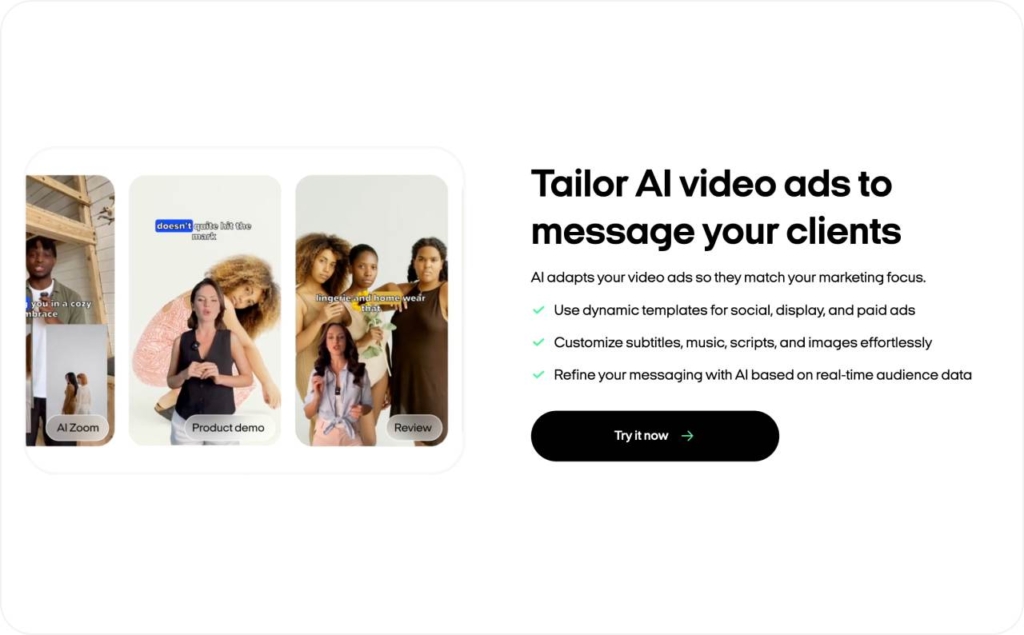
One DTC skincare brand used Zeely to replace their 3-week agency turnaround with 48-hour asset delivery. They launched five ad variants across Meta and TikTok without compromising their premium voice and saw immediate results: 28% lower cost-per-result and a 31% drop in cost-per-acquisition.
What sets Zeely apart from other AI ad tools?
While other tools may offer automation, Zeely focuses on automated authenticity. You don’t just get plug-and-play videos — you get content that mirrors real user testimonials and adheres to your brand guardrails. Customizable scripts, persona-driven visuals, and platform-specific sizing make it easy to create, test, and iterate content across channels.
Testimonials from marketing teams highlight ease of use:
“We created 12 personalized video ads in two hours, and every one sounded like it came from our actual users.” – Growth Lead, HealthTech Startup
Whether you’re launching a new product, running A/B tests, or scaling seasonal campaigns, Zeely helps you create branded UGC at scale without sacrificing trust or wasting budget.
The outcome: Faster production, better performance
Using Zeely means fewer bottlenecks, faster content cycles, and more room to experiment. Most teams report launching high-performing creative 2–3x faster, while maintaining consistent brand messaging across markets. Its predictive optimization tools even recommend which ad variations are likely to perform best, helping you save both time and ad spend.
If you’re looking for a scalable way to simplify video ad production, stay on-brand, and drive better performance, Zeely isn’t just another AI tool, it’s your creative partner.
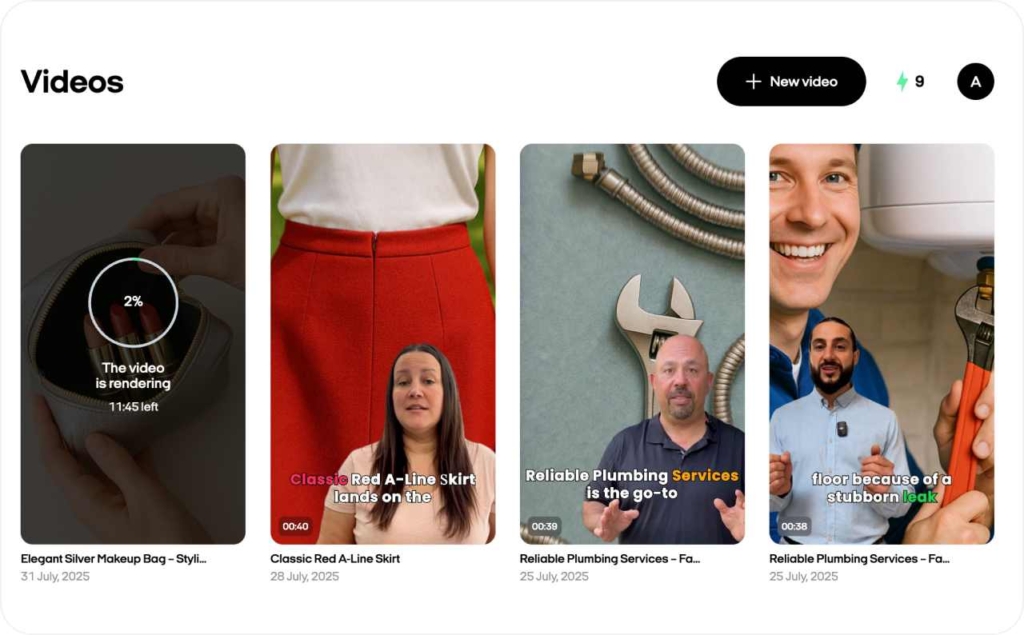
Best practices & tips for ad success
You’ve got the tools. You’ve got the assets. Now, it’s time to make them work harder. Whether you’re launching polished brand ads or scaling fast with AI UGC content, success hinges on smart execution. This section breaks down the strategies, metrics, and optimizations that separate average campaigns from high-converting ones.
Focus on conversion, not just impressions
It’s tempting to chase likes and views, but engagement doesn’t equal sales. To run effective campaigns, shift your attention to conversion metrics like click-through rate, cost per acquisition, and return on ad spend. These are the numbers that truly reflect success.
According to Meta’s internal data, campaigns that optimize for conversion rather than reach generate up to 31% lower CPA. That’s your baseline: optimize for outcomes, not vanity.
Start with A/B testing
If you’re not testing, you’re guessing. Every campaign should include at least one structured A/B test. This could be as simple as comparing two UGC video hooks or testing a branded CTA versus a personalized one. The key is to isolate one variable at a time, measure impact, and scale what works.
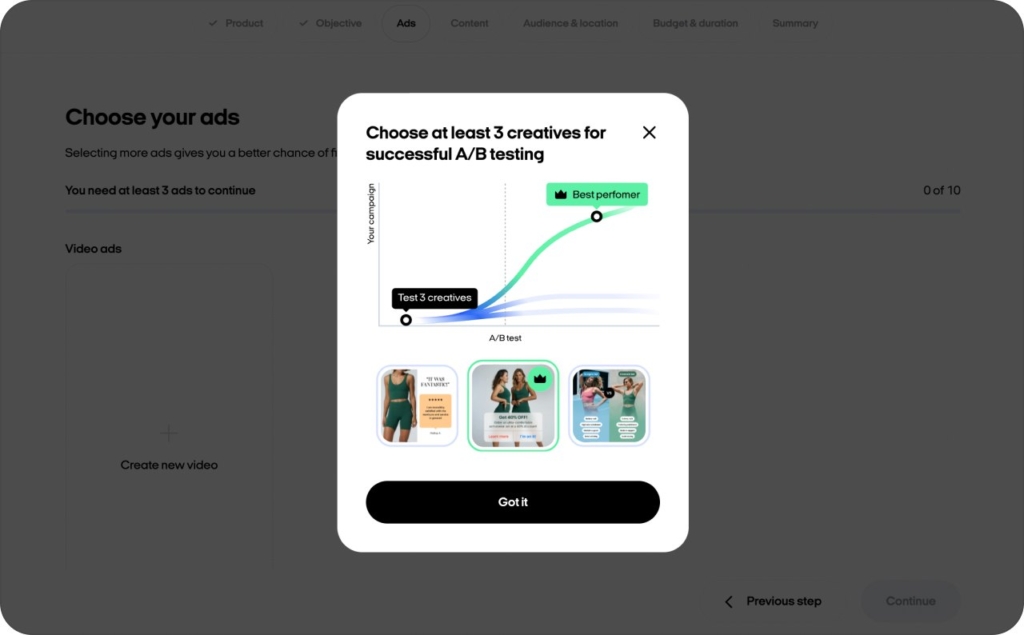
Pro tip: Use platform-native testing tools like Meta Experiments or Google Ads’ draft & experiment features. These ensure your results are statistically reliable and not just based on gut feel.
Balance authenticity and quality
Not every audience wants a highly polished branded ad. And not every product should be promoted with lo-fi UGC. The trick is knowing when to use which. For top-of-funnel awareness? Lean on AI UGC ads for relatability and reach. For bottom-of-funnel conversions? Branded videos with crisp CTAs and professional framing usually win.
A hybrid campaign — one that combines automated UGC assets with a branded anchor video, can drive stronger engagement across the funnel. Zeely AI, for instance, enables quick UGC generation that matches your brand guidelines, giving you flexibility without sacrificing message control.
Set clear KPIs and review often
Your campaign isn’t truly optimized unless you’re measuring against the right goals. Define your KPIs before you hit “publish.” Are you tracking conversion rate, scroll depth, watch-through rate, or add-to-cart actions? Each format excels in different areas.
Review your performance weekly, not just at the end. Look for patterns, what’s holding attention, where people drop off, and how different creatives compare. Use those insights to refine in real time.
Turn insights into action
Finally, don’t just report on performance — act on it. If a UGC testimonial outperforms a brand voice-over, double down. If your CTR dips after 5 seconds, test a new opener. The best advertisers treat performance data as a creative tool, not just a postmortem.
Conclusion: Choosing the right ad strategy for real results
With so many ad formats and platforms competing for attention, making the right choice can feel like a gamble. But it doesn’t have to be. The path to effective advertising is clearer when you match your strategy to the specific goals of your campaign.
Use brand-created ads when your message demands polish, consistency, and control, such as during product launches or brand-building efforts where creative direction is non-negotiable. Lean into AI UGC ads when speed, personalization, and cost-efficiency matter most. These formats excel in social campaigns, rapid testing, and content at scale, especially when paired with platforms like Zeely AI.
More and more brands are adopting hybrid ad strategies that combine the strengths of both formats — professional quality meets authentic tone. This approach unlocks both performance and brand equity, letting you scale without losing connection or control.
Deciding your next move doesn’t require guesswork. Use the insights from this guide to weigh creative needs against timelines, budgets, and engagement targets. Then execute with precision — test, refine, and adapt as the data comes in.
And if you’re ready to bring your campaigns to life with on-brand UGC at scale, Zeely AI is built to make that effortless.
The future of advertising is flexible, fast, and strategically aligned. Now it’s your move.
Also recommended
